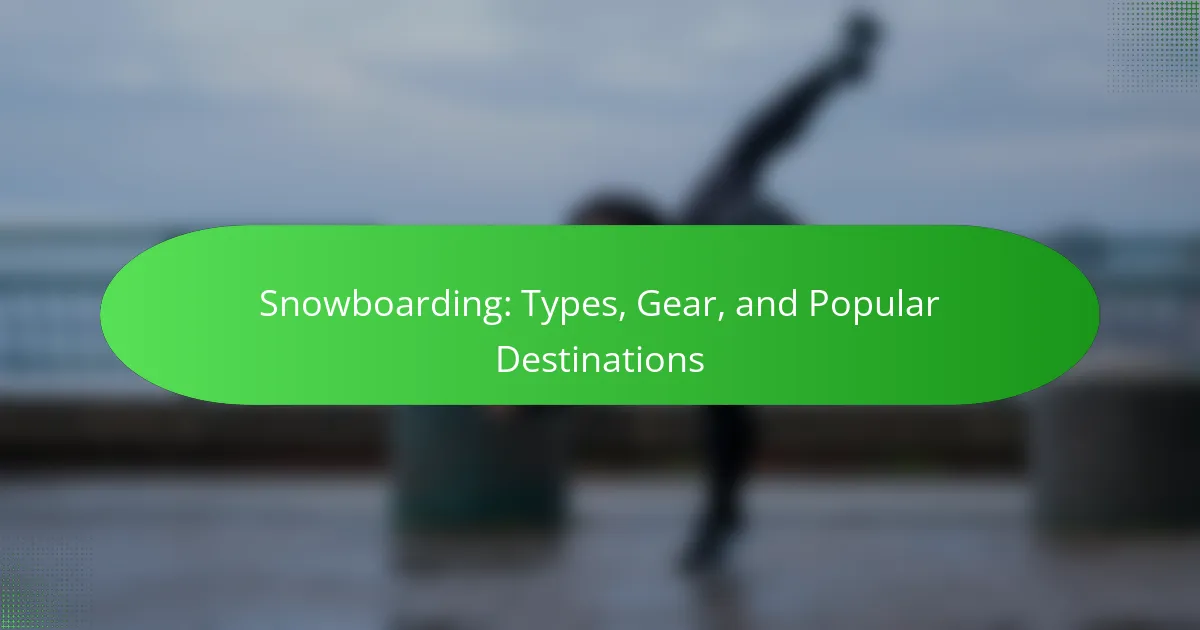Snowboarding offers thrilling experiences across various styles, including freestyle, freeride, alpine, and cross. Selecting the right gear is crucial for safety and performance. Popular destinations like Whistler Blackcomb, Aspen, Chamonix, and Niseko provide diverse terrains and excellent snow conditions. Understanding safety measures and environmental impacts is essential for a responsible snowboarding experience.

What are the different styles of snowboarding?
Snowboarding features several styles, each catering to different preferences and skill levels. The primary styles include freestyle, freeride, alpine, and cross.
Freestyle snowboarding emphasizes tricks and jumps, typically performed in terrain parks. Freeride focuses on off-piste and backcountry riding, allowing exploration of natural landscapes. Alpine snowboarding is characterized by carving turns on groomed runs, prioritizing speed and precision. Cross, or snowboard cross, involves racing on a course with obstacles and jumps.
Each style requires specific gear tailored to performance needs, enhancing the overall experience.
How do freestyle and freeride snowboarding differ?
Freestyle and freeride snowboarding differ primarily in style and terrain. Freestyle focuses on tricks and park features, while freeride emphasizes natural terrain and off-piste riding.
Freestyle snowboarding often takes place in terrain parks, featuring jumps, rails, and halfpipes. Riders prioritize creativity and technical skills. Freeride snowboarding, on the other hand, involves navigating backcountry areas, emphasizing powder and challenging landscapes.
Freestyle boards are typically shorter and more flexible for maneuverability. Freeride boards are longer and stiffer for stability at high speeds. Both styles require specific gear tailored to their unique demands.
Which snowboarding styles are best for beginners?
The best snowboarding styles for beginners are freestyle and all-mountain. Freestyle focuses on tricks and jumps, while all-mountain provides versatility across various terrains. Both styles allow new riders to develop skills and confidence effectively.

What essential gear do you need for snowboarding?
To snowboard effectively, you need a snowboard, boots, bindings, helmet, goggles, and appropriate clothing. These essentials ensure safety, comfort, and performance on the slopes.
1. Snowboard: Choose based on skill level and riding style.
2. Boots: Ensure a snug fit for better control.
3. Bindings: Select compatible ones for your board and boots.
4. Helmet: Prioritize safety; look for a certified model.
5. Goggles: Opt for anti-fog and UV protection features.
6. Clothing: Layer appropriately with waterproof and breathable materials.
How to choose the right snowboard for your style?
To choose the right snowboard for your style, consider your riding style, skill level, and the terrain you prefer. Identify whether you favor freestyle, all-mountain, or powder riding.
1. Determine your skill level: Beginner, intermediate, or advanced.
2. Select the board type: Freestyle boards are shorter and more flexible, while all-mountain boards offer versatility.
3. Evaluate board length: This should match your height and weight for optimal control.
4. Consider the board’s flex: Softer boards are better for beginners; stiffer boards suit advanced riders.
5. Assess your preferred terrain: Choose a board that performs well on the snow conditions you encounter most often.
By focusing on these factors, you can find a snowboard that enhances your experience and matches your unique riding style.
What are the key features of snowboarding boots?
Snowboarding boots feature critical elements that enhance performance and comfort. Key features include flex rating, which determines stiffness; insulation for warmth; waterproofing to keep feet dry; and lacing systems for a secure fit. Additionally, some boots offer heat-moldable liners for customized comfort. Advanced models may include unique attributes like built-in ankle support or lightweight materials for agility.
How do bindings affect your snowboarding experience?
Bindings significantly enhance your snowboarding experience by providing control, stability, and comfort. They connect your boots to the board, influencing your ability to maneuver and absorb shocks.
The right bindings can improve responsiveness, allowing for quicker turns and better edge control. Different types, like strap or rear-entry bindings, cater to various riding styles, from freestyle to all-mountain.
Bindings also come with unique attributes such as flex ratings, which affect how they perform in different conditions. For instance, softer flex bindings offer more comfort and playfulness, while stiffer ones provide precision and support at high speeds.
Investing in quality bindings suited to your skill level and riding style can lead to a more enjoyable and efficient snowboarding experience.

What are the most popular snowboarding destinations worldwide?
The most popular snowboarding destinations worldwide include Whistler Blackcomb in Canada, Aspen in the USA, Chamonix in France, and Niseko in Japan. These locations offer diverse terrains, excellent snow conditions, and vibrant après-ski scenes.
Whistler Blackcomb features over 8,000 acres of skiable terrain and receives an average of 33 feet of snowfall annually. Aspen is renowned for its luxury accommodations and four distinct ski areas. Chamonix, known as the capital of extreme sports, offers breathtaking views of Mont Blanc. Niseko is famous for its light powder snow and night skiing opportunities.
These destinations cater to various skill levels and preferences, making them ideal for both beginners and seasoned snowboarders.
Which locations offer the best snowboarding conditions?
Top locations for snowboarding with the best conditions include Whistler Blackcomb in Canada, Aspen in the USA, and Chamonix in France. These destinations feature diverse terrains, reliable snowfall, and excellent facilities. Whistler Blackcomb offers over 8,000 acres of skiable terrain, while Aspen boasts four mountains catering to various skill levels. Chamonix is renowned for its off-piste opportunities and breathtaking scenery. Each location provides unique attributes that enhance the snowboarding experience, making them popular choices among enthusiasts.
What are the cultural influences on snowboarding in different regions?
Cultural influences on snowboarding vary significantly across regions. In North America, snowboarding embodies a lifestyle with roots in skate and surf culture. European regions emphasize alpine traditions, blending snowboarding with local customs and styles. In Japan, snowboarding reflects a deep respect for nature and incorporates Zen philosophies. Each region’s unique terrain and climate also shape gear preferences and riding techniques.

How does snowboarding gear vary by region?
Snowboarding gear varies by region due to climate, terrain, and local preferences. In colder regions, heavier insulation and waterproof materials are common, while warmer areas favor lighter gear for comfort. For example, Western U.S. resorts often use high-performance gear suited for powder snow, while East Coast gear focuses on versatility for icy conditions. Additionally, cultural influences shape style choices, with urban areas favoring trendy designs and colors.
What unique attributes do Canadian snowboarding brands offer?
Canadian snowboarding brands offer unique attributes such as innovative designs, eco-friendly materials, and local craftsmanship. These brands often focus on performance, durability, and sustainability, catering to the specific needs of snowboarding enthusiasts. For example, some brands utilize recycled materials, enhancing their environmental responsibility. Additionally, many Canadian brands incorporate traditional craftsmanship, providing a distinct aesthetic and quality that stands out in the market.
How do European snowboarding trends differ from North American ones?
European snowboarding trends emphasize freestyle and park riding, while North American trends focus more on backcountry and powder. European resorts often feature more urban-style parks, leading to different gear preferences and riding styles. For example, the European market favors shorter, more maneuverable boards, while North American riders typically choose longer boards for stability in varied terrain. Additionally, cultural influences shape the snowboarding community, with Europe embracing a more artistic approach, contrasting with North America’s performance-driven mindset.

What are the safety considerations for snowboarding?
Snowboarding safety considerations include wearing protective gear, understanding terrain, and being aware of weather conditions. Helmets are essential to prevent head injuries, while wrist guards can protect against fractures. Staying within skill limits reduces the risk of accidents. Familiarize yourself with snowboarding etiquette to ensure safety for yourself and others on the slopes. Always check avalanche risks in backcountry areas.
How can you prevent injuries while snowboarding?
To prevent injuries while snowboarding, prioritize proper gear, technique, and awareness. Wearing a helmet significantly reduces head injury risk. Use appropriate snowboarding boots and bindings to enhance control. Practicing basic techniques, like falling correctly, helps minimize injury severity. Additionally, stay aware of surroundings and other riders to avoid collisions.
What safety gear is essential for snowboarding?
Essential safety gear for snowboarding includes a helmet, goggles, wrist guards, knee pads, and padded shorts. Helmets protect against head injuries, while goggles enhance visibility. Wrist guards prevent fractures, and knee pads and padded shorts provide cushioning during falls. Prioritizing this gear significantly reduces injury risk on the slopes.

What are the environmental impacts of snowboarding?
Snowboarding can negatively impact the environment through habitat disruption, increased carbon emissions, and resource depletion. Ski resorts often require deforestation, which affects local ecosystems. Additionally, snowmaking relies on significant water and energy resources. As a result, snowboarding contributes to climate change and biodiversity loss.
How can snowboarding communities promote sustainability?
Snowboarding communities can promote sustainability by adopting eco-friendly practices and raising awareness. They can organize clean-up events at popular destinations, educate members about responsible gear usage, and support local environmental initiatives. Collaboration with brands that prioritize sustainable materials fosters a culture of environmental responsibility. Engaging in advocacy for conservation policies can also amplify their impact on preserving snowboarding environments.
What are the rare snowboarding events that celebrate the sport?
Rare snowboarding events include the World Snowboarding Championships, the X Games Real Snow, and the Red Bull Supernatural. These events highlight unique skills and creativity, celebrating the sport’s diversity. The World Snowboarding Championships gathers elite riders for global competition, while the X Games Real Snow features video parts judged by a panel. The Red Bull Supernatural showcases innovative terrain and challenges, emphasizing freestyle and backcountry snowboarding. Each event contributes to the sport’s evolution and popularity.
What expert tips can enhance your snowboarding experience?
To enhance your snowboarding experience, focus on mastering techniques, choosing the right gear, and selecting ideal locations.
1. Improve your skills through lessons or tutorials. Professional instruction can significantly enhance your technique and confidence on the slopes.
2. Invest in quality gear tailored to your skill level and style. A well-fitted snowboard and appropriate boots are crucial for comfort and performance.
3. Explore diverse terrains and conditions. Different locations offer unique experiences; try resorts known for varied slopes and snow conditions.
4. Stay informed about weather and snow reports. Understanding conditions helps you plan your trips for optimal snowboarding experiences.
